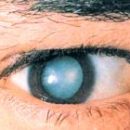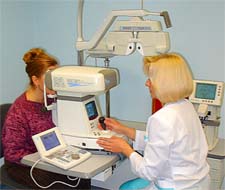According to statistics, more than 10 million people around the world have problems with the cornea of the eye. The pathology of the corneals make up 25% of the total number of eye diseases.
Content
The cornea of the eye is a transparent shell covering the front of the eye, and is one of the most important structures of the optical system of the eye. Corneal transparency provides a layer of endothelial cells. The number of endothelial cells during life is gradually decreasing from 3500 per mm2 at birth to 1500–2000 cells per mm2 at the age of 80.
In addition to age factors, the decrease in the density of these cells may occur due to various diseases, in T.C. inflammation, dystrophy, injuries, operations and t.D. With cell density below 1200 per mm2 cornea loses its transparency, it becomes muddy, swells, there is constant tearing, pain, pain.
Causes of the development of corneal pathologies?
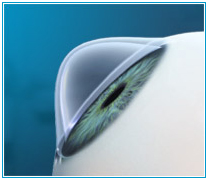 Factors that contribute to the emergence of corneal diseases quite a lot, and, unfortunately, every year they are becoming more and more: it is an ecological situation, injury, infections, genetic features. Supplements related to violation of the use of contact correction, negative consequences of ophthalmic operations, relative frequency of household and industrial injuries. Such changes are sometimes not determined visually and can only be detected using biomicroscopic research during diagnostics.
Factors that contribute to the emergence of corneal diseases quite a lot, and, unfortunately, every year they are becoming more and more: it is an ecological situation, injury, infections, genetic features. Supplements related to violation of the use of contact correction, negative consequences of ophthalmic operations, relative frequency of household and industrial injuries. Such changes are sometimes not determined visually and can only be detected using biomicroscopic research during diagnostics.
Among the pathologies of the cornea is also found Keratokonus — Genetically determined disease of the corneal tissue, leading to its dystrophy and thinning of the cornea. As a result, the cornea, instead of spherical, takes an incorrect (conical) form, which causes significant and irreversible distortions in eye optics.
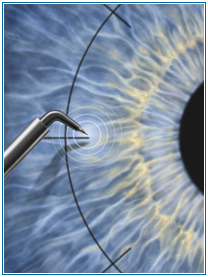 Distortion of view caused by corneal pathologies associated with the violations of its transparency or form are irreversible and not corrected with standard optical means (glasses, contact lenses). The only way to solve such problems — This is an operation — Keratoplasty (partial or complete replacement of a damaged corneal area).
Distortion of view caused by corneal pathologies associated with the violations of its transparency or form are irreversible and not corrected with standard optical means (glasses, contact lenses). The only way to solve such problems — This is an operation — Keratoplasty (partial or complete replacement of a damaged corneal area).
When needed keratoplasty?
The corneal pathologies requiring keratoplasty include:
- Keratoconus;
- Various kinds of belch cornea — burn and dystrophic;
- Congenital and acquired corneal dystrophy;
- Scars of the cornea, after injury, operations and inflammation;
- Traumatic corneal defects.
Until recently, corneal transplant operations were a certain difficulty. First of all, the problem was uncertainty in the law on donation. In addition, difficulties were also in obtaining high-quality donor material: not all doctors had access to the transplant bank. A huge number of people in the years were on a donor corneal expectation sheet.
A very important point is that the material that has been used earlier for the cornea transplant has a limited shelf life: one day. The decision on the operation was necessary to be taken as soon as possible, and this was not always convenient for the patient. The choice of the characteristics of the implantable material was practically no, also not conducted a survey of the viability of the cornea and the study of the number of endothelial cells.
No patient could be insured against the fact that the donor material does not fit, it does not fit and will not cause the need for a re-operation. To date, there is a solution to this problem! Since July 2011 in ophthalmologic clinics «EXIMER» A unique service is available – keratoplasty.
Keratoplasty is to replace the damaged area of the cornea. As a material for replacement in ophthalmic clinics «EXIMER» Used «Corneal transplant». The unique material was clinical trials and has all the necessary registration documents and certificates of Roszrava.
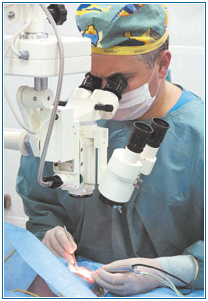 Thanks to the new technology and the storage system of biomaterial in doctors «Excimer» Now it is possible to help patients with cornea pathologies.
Thanks to the new technology and the storage system of biomaterial in doctors «Excimer» Now it is possible to help patients with cornea pathologies.
- Preparation for surgical intervention in «Eksimer» It begins with a full examination of the visual system, which allows doctors to identify the disease in the earliest stages, determine the testimony for the operation, as well as to predict its result.
- During operation, the surgeon with the help of a microsurgical instrument or femtosecond laser forms a corneal flap and separates the damaged part of the cornea. Implant in her place «Corneal transplant», which exactly corresponds to the sizes of the previously formed flap. With the help of a specially suture material, it joins the peripheral part of the patient's cornea. After the end of the operation on the eye of the patient is superimposed by a bandage or a special protective contact lens.
- Keratoplasty in the clinic «EXIMER» Outpatient, under anesthesia or under local (parabulbar) anesthesia, using modern drugs, which do not have a load on the cardiovascular system and is well transferred to patients of different ages. After the operation and examination of the doctor, the patient returns home, which, of course, contributes to the most comfortable recovery.
- The rehabilitation period after keratoplasty lasts up to a year, due to the characteristics of the cornea structure. During this period, the patient regularly observed at his attending physician in the clinic «EXIMER», which monitors the recovery dynamics. Removing seams usually occurs 6-12 months after surgery.
In most cases, the result of keratoplasty in the clinic «EXIMER» Successful: The cornea remains transparent, good visual characteristics are achieved. The possibilities of the clinic «EXIMER» Allowed to cope with postoperative astigmatism with the help of excimer-laser vision correction.
Features of keratoplasty in the clinic «EXIMER»
- The emergence of the new technology of keratoplasty gives the opportunity to doctors clinic «EXIMER» solve problems of corneal pathologies, on a qualitatively new level;
- Applicable equipment, disposable tools and consumables in the clinic «EXIMER» comply with all international standards, passed strict clinical trials and have the necessary certificates and permits;
- Postoperative complications and recovery period are minimized, maximum result is achieved;
- At doctors «Excimer» There are constant access to the biomaterial bank and the possibility of carrying out the operation depends only on the wishes of the patient and individual indications for the conduct of keratoplasty;
- Biomaterial («Corneal transplant») is selected based on the standards of the leading ophthalmic clinics of the world, repeated studies are conducted not only by biological and virological, but also studies of the endothelial cell layer, which make it possible to make a forecast for its further viability and the results of the future operation;
- Unlike previously used materials, «Corneal transplant», It has better adhesion, significantly reduced risk of clouding. Using such bio-material, ophthalmoshurge «Excimer» achieve best optical characteristics.
Ophthalmologic clinics «EXIMER» always go one step ahead and now the clinic doctors have the opportunity to help those who have been practically impossible to help yesterday.
If you have vision problems, then the doctors of the clinic «EXIMER» ready to provide you with any ophthalmic help at the most modern level. All of interest you questions You can set in on-line mode. When writing to receive Via the clinic's website is provided with a 5% discount on full computer diagnostics with an ophthalmologist's consultation.
We will be happy to help you and be healthy!

